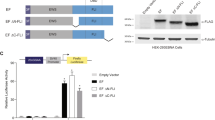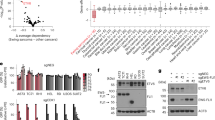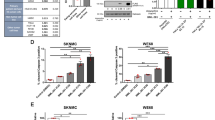Abstract
In approximately 85% of Ewing sarcomas, chromosomal translocations give rise to the chimeric gene EWS/FLI, encoding the N-terminus of the RNA binding protein EWS fused to the DNA-binding domain of the ETS protein FLI-1. EWS/FLI is a stronger transcriptional activator than wild-type FLI-1, although both proteins bind to the same DNA sequences in vitro. In addition, EWS/FLI, but not FLI-1, is a transforming oncogene in NIH3T3 fibroblasts. EWS/FLI is thought to transform through its ability to deregulate the expression of target genes. We introduced several point mutations into the ETS domain of EWS/FLI that abolished DNA-binding activity. Although two of these mutations disrupted the transforming activity of EWS/FLI, one mutated protein containing a substitution of isoleucine 347 with glutamic acid (I347E) retained diminished transforming activity. In addition, EWS/FLI I347E did not activate expression of the endogenous EWS/FLI target gene manic fringe (MFNG). These studies demonstrate that a portion of the oncogenic activity of EWS/FLI is independent of FLI DNA-binding activity.
This is a preview of subscription content, access via your institution
Access options
Subscribe to this journal
Receive 50 print issues and online access
$259.00 per year
only $5.18 per issue
Buy this article
- Purchase on Springer Link
- Instant access to full article PDF
Prices may be subject to local taxes which are calculated during checkout




Similar content being viewed by others
References
Bailly RA, Bosselut R, Zucman J, Cormier F, Delattre O, Roussel M, Thomas G and Gysdael J . 1994 Mol. Cell. Biol. 14: 3230–3241.
Barr FG. . 1998 Nat. Genet. 19: 121–124.
Ben-David Y and Bernstein A. . 1991 Cell 66: 831–834.
Bosselut R, Duvall JF, Gegonne A, Bailly M, Hemar A, Brady J and Gysdael J. . 1990 EMBO J. 9: 3137–3144.
Carrere S, Verger A, Flourens A, Stehelin D and Duterque-Coquillaud M. . 1998 Oncogene 16: 3261–3268.
Chang CP, de Vivo I and Cleary ML. . 1997 Mol. Cell Biol. 17: 81–88.
Crozat A, Aman P, Mandahl N and Ron D. . 1993 Nature 363: 640–644.
Delattre O, Zucman J, Plougastel B, Desmaze C, Melot T, Peter M, Kovar H, Joubert I, de Jong P, Rouleau G, Aurias A and Thomas G. . 1992 Nature 359: 162–165.
Dubnau J and Struhl G. . 1996 Nature 379: 694–699.
Hallier M, Lerga A, Barnache S, Tavitian A and Moreau-Gachelin F. . 1998 J. Biol. Chem. 273: 4838–4842.
Hallier M, Tavitian A and Moreau-Gachelin F. . 1996 J. Biol. Chem. 271: 11177–11181.
Ichikawa H, Shimizu K, Hayashi Y and Ohki M. . 1994 Cancer Res. 54: 2865–2868.
Inukai T, Inaba T, Ikushima S and Look AT. . 1998 Mol. Cell Biol. 18: 6035–6043.
Jeon IS, Davis JN, Braun BS, Sublett JE, Roussel MF, Denny CT and Shapiro DN. . 1995 Oncogene 10: 1229–1234.
Kinzler KW, Ruppert JM, Bigner SH and Vogelstein B. . 1988 Nature 332: 371–374.
Labelle Y, Zucman J, Stenman G, Kindblom LG, Knight J, Turc-Carel C, Dockhorn-Dworniczak B, Mandahl N, Desmaze C, Peter M et al. 1995 Hum. Mol. Genet. 4: 2219–2226.
Ladanyi M and Gerald W. . 1994 Cancer Res. 54: 2837–2840.
Ladomery M. . 1997 Bioessays 19: 903–909.
Lam PYP, Sublett JE, Hollenbach AD and Roussel MF. . 1999 Mol. Cell. Biol. 19: 594–601.
Look AT. . 1997 Science 278: 1059–1064.
Mao X, Miesfeldt S, Yang H, Leiden JM and Thompson CB. . 1994 J. Biol. Chem. 269: 18216–18222.
May WA, Arvand A, Thompson AD, Braun BS, Wright M and Denny CT. . 1997 Nat. Genet. 17: 495–497.
May WA, Gishizky ML, Lessnick SL, Lunsford LB, Lewis BC, Delattre O, Zucman J, Thomas G and Denny CT. . 1993a Proc. Natl. Acad. Sci. USA 90: 5752–5756.
May WA, Lessnick, SL, Braun BS, Klemsz M, Lewis BC, Lunsford LB, Hromas R and Denny CT. . 1993b Mol. Cell. Biol. 13: 7393–7398.
Michelotti EF, Michelotti GA, Aronsohn AI and Levens D. . 1996 Mol. Cell. Biol. 16: 2350–2360.
Muller AJ, Young JC, Pendergast AM, Pondel M, Landau NR, Littman DR and Witte ON. . 1991 Mol. Cell. Biol. 11: 1785–1792.
Nye JA, Petersen JM, Gunther CV, Jonsen MD and Graves BJ. . 1992 Genes Dev. 6: 975–990.
Ohno T, Rao VN and Reddy ES. . 1993 Cancer Res. 53: 5859–5863.
Panagopoulos I, Hoglund M, Mertens F, Mandahl N, Mitelman F and Aman P. . 1996 Oncogene 12: 489–494.
Peter M, Couturier J, Pacquement H, Michon J, Thomas G, Magdelenat H and Delattre O. . 1997 Oncogene 14: 1159–1164.
Pio F, Kodandapani R, Ni CZ, Shepard W, Klemsz M, McKercher SR, Maki RA and Ely KR. . 1996 J. Biol. Chem. 271: 23329–23337.
Rabbitts TH. . 1994 Nature 372: 143–149.
Rabbitts TH, Forster A, Larson R and Nathan P. . 1993 Nat. Genet. 4: 175–180.
Rivera-Pomar R, Niessing D, Schmidt-Ott U, Gehring WJ and Jackle H. . 1996 Nature 379: 746–749.
Seth A, Ascione R, Fisher RJ, Mavrothalassitis GJ, Bhat NK and Papas TS. . 1992 Cell Growth Differ. 3: 327–334.
Sorensen PH, Lessnick SL, Lopez-Terrada D, Liu XF, Triche TJ and Denny CT. . 1994 Nat. Genet. 6: 146–151.
Soudant N, Albagli O, Dhordain P, Flourens A, Stehelin D and Leprince D. . 1994 Nucleic. Acids Res. 22: 3871–3879.
Thayer MJ and Weintraub H. . 1993 Proc. Natl. Acad. Sci. USA 90: 6483–6487.
Treisman R. . 1994 Curr. Opin. Genet. Dev. 4: 96–105.
Turc-Carel C, Aurias A, Mugneret F, Lizard S, Sidaner I, Volk C, Thiery JP, Olschwang S, Philip I, Berger MP et al. 1988 Cancer Genet. Cytogenet. 32: 229–238.
Urano F, Umezawa A, Hong W, Kikuchi H and Hata J. . 1996 Biochem. Biophys. Res. Commun. 219: 608–612.
Wasylyk B, Hahn SL and Giovane A. . 1993 Eur. J. Biochem. 211: 7–18.
Zucman J, Delattre O, Desmaze C, Epstein AL, Stenman G, Speleman F, Fletchers CD, Aurias A and Thomas G. . 1993 Nat. Genet. 4: 341–345.
Acknowledgements
We thank Frank Rauscher, The Wistar Institute, for pCB6+, Charles Sawyers, UCLA Medical Center, for pSRα(ΔHindIII)-tk-Neo retroviral vector, David Baltimore, California Institute of Technology, for 293T cells, Clare Sample, St Jude Children's Research Hospital, for PU.1 cDNA, and Timothy J Triche, Children's Hospital, USC, for TC252 cells. We also thank Tom Curran, Peter J McKinnon and Stephen W White for helpful discussions. This work was supported in part by NIH grants PO1-CA-71907 (SJ Baker and MF Roussel), the Cancer Center Support CORE grant P30 CA21765 and by the American Lebanese Syrian Associated Charities (ALSAC).
Author information
Authors and Affiliations
Rights and permissions
About this article
Cite this article
Jaishankar, S., Zhang, J., Roussel, M. et al. Transforming activity of EWS/FLI is not strictly dependent upon DNA-binding activity. Oncogene 18, 5592–5597 (1999). https://doi.org/10.1038/sj.onc.1202940
Received:
Revised:
Accepted:
Published:
Issue Date:
DOI: https://doi.org/10.1038/sj.onc.1202940
Keywords
This article is cited by
-
Mutant screening for oncogenes of Ewing’s sarcoma using yeast
Applied Microbiology and Biotechnology (2015)
-
EWS/ETS proteins promote expression and regulate function of the homeodomain transcription factor BRN3A
Oncogene (2010)
-
The EWS/FLI1 oncogenic transcription factor deregulates GLI1
Oncogene (2008)
-
The Potential for molecular therapeutic targets in Ewing’s sarcoma
Current Treatment Options in Oncology (2005)
-
Utility of the immunohistochemical detection of FLI-1 expression in round cell and vascular neoplasm using a monoclonal antibody
Modern Pathology (2004)



